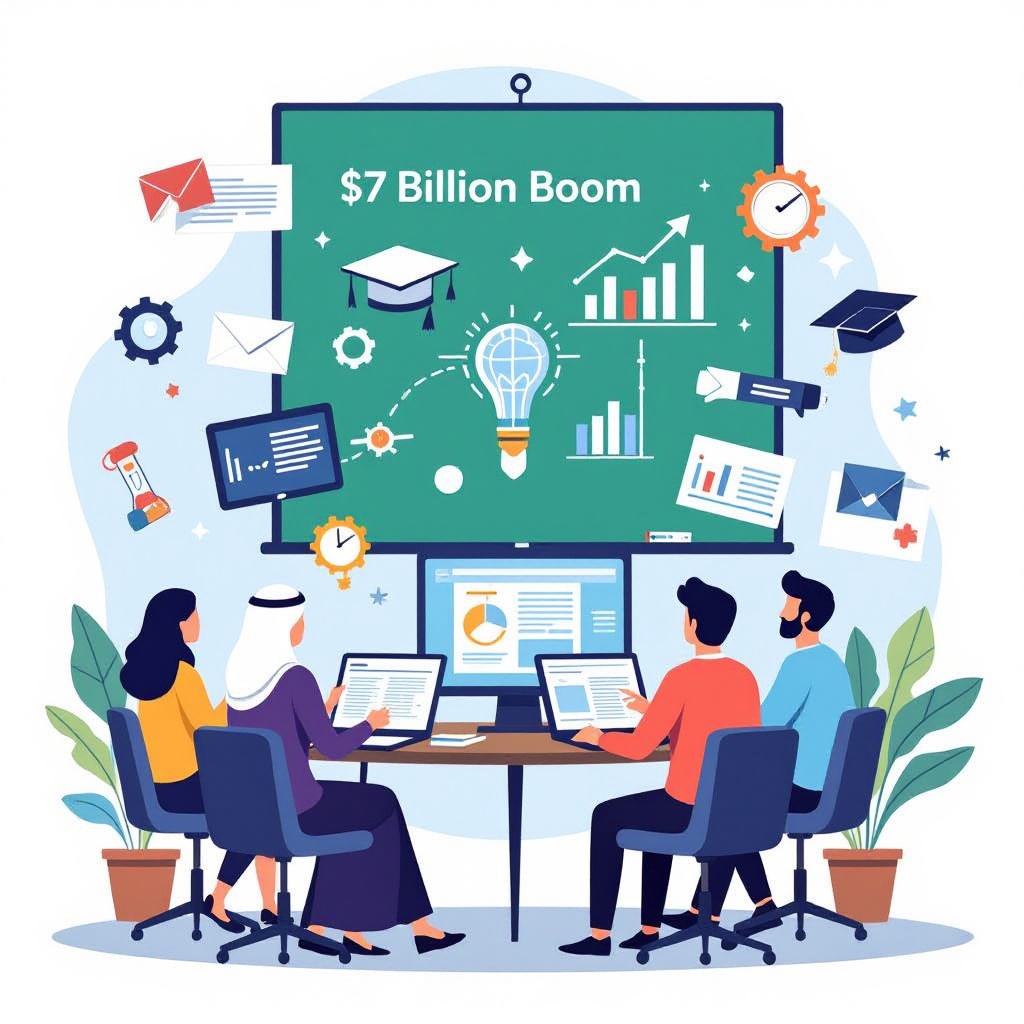Saudi Arabia’s e-learning transformation is gaining momentum, with projections indicating a remarkable growth from USD 2.4 billion in 2024 to USD 7 billion by 2033. Powered by Vision 2030, this dynamic change is setting new benchmarks in education. Technological advancements, flexible learning options, and strategic government investments are driving this shift, positioning Saudi Arabia as a leader in digital learning globally.
Key Takeaways:
- The Saudi e-learning market is set to expand at a 12.7% CAGR, reaching USD 7 billion by 2033.
- Initiatives like the Madrasati platform are crucial for broadening access to digital education nationwide.
- High internet penetration enables the seamless integration of virtual classrooms and augmented reality, boosting student engagement.
- Both educational and corporate sectors see benefits as e-learning tools facilitate academic and employee skill enhancement.
- The move to flexible, self-paced learning supports students and professionals, nurturing a workforce ready for future challenges.
Unveiling the Saudi E-Learning Market Surge
Saudi Arabia’s e-learning market is making waves, valued at an impressive USD 2.4 billion in 2024. It’s set to skyrocket to USD 7.0 billion by 2033, with a compound annual growth rate (CAGR) of 12.7%. What’s even more striking is the broader Saudi e-learning services sector, which earned USD 2.93 billion in 2024 and is anticipated to reach USD 6.71 billion by 2030, posting a slightly higher CAGR of 14.7%.
Why this explosive growth? As technology becomes more integral to daily life, the demand for flexible, accessible education swells. With global trends shifting towards digital learning, Saudi Arabia is poised to become a key player. For those interested in the broader impact and future of e-learning, resources like EdTech Magazine provide valuable insights.

Vision 2030: The Strategic Blueprint Behind the E-Learning Expansion
Saudi Vision 2030 is a groundbreaking agenda setting the path for digital transformation in education, steering the nation away from oil dependency and enhancing its human capital. With this dynamic shift, Saudi Arabia is gaining momentum in the e-learning sector. Initiatives like the Ministry of Education’s Madrasati platform and Distance Learning Initiative play crucial roles in making online education widespread.
Madrasati stands out as more than just a platform; it’s a cornerstone of Saudi Arabia’s e-learning capabilities. It offers students and teachers a virtual classroom experience, where resources are plentiful and accessible from anywhere. Then there’s the Distance Learning Initiative, supporting remote educational practices across the kingdom.
Government investment in these areas has been monumental. By allocating resources into edtech infrastructure, platforms, and teacher training, the kingdom is ensuring that both students and educators thrive in an online environment. A well-rounded approach to education modernization helps prepare future generations for a diversified economy.
For more on Saudi Vision 2030 and how it’s transforming various sectors, you might want to check out Vision 2030. Additionally, if you’re interested in the global impact of e-learning, EdTech Magazine offers some compelling insights.
These strategic initiatives are setting the stage for a new era in education. So many opportunities are opening up for students, making the e-learning revolution a game-changer in Saudi Arabia.

The Role of Technology in Revolutionizing Education
Technology has fundamentally altered how education is accessed in Saudi Arabia, with internet and smartphone accessibility at the core of this transformation. Boasting high internet penetration rates, students can now tap into e-learning resources from anywhere, making education more inclusive and flexible. This connectivity is vital for engaging students in ways traditional classrooms simply cannot.
Many students are now enjoying the perks of cutting-edge virtual classrooms, which have become a staple in the educational landscape. These digital spaces offer an interactive environment that mimics the sociability of physical classrooms, increasing engagement among students. Moreover, integrating augmented reality (AR) is taking educational experiences to new heights, providing immersive content that makes learning not only informative but also fun. Learn more about AR’s influence in education on EdTech Magazine.
Interactive learning platforms further contribute to this engaging atmosphere with gamified elements that captivate students’ attention and foster a deeper understanding of subjects. By turning lessons into games or interactive tasks, students often grasp complex concepts more effectively, maintaining their interest and enthusiasm.
Saudi Arabia’s solid digital infrastructure supports these advancements, ensuring that educational technology is more than just an overlay; it’s a meaningful part of students’ everyday learning experiences. As students leverage these technological innovations, they’re better prepared for a future that demands ever more digital proficiency. The shift is indeed revolutionary, providing all with the tools needed to succeed in today’s fast-paced world.

E-Learning’s Diverse Audience: From Classroom to Corporate
E-learning in Saudi Arabia is broadening its horizons, bringing together K–12, higher education, and vocational training in a cohesive blend. The academic segment remains the biggest slice of the market, driven largely by a noticeable increase during the pandemic. Institutions now integrate interactive content, virtual classrooms, and complete online degrees as part of their standard offerings.
But the transformation doesn’t stop there. On the corporate side, e-learning is expanding fast. Businesses use these tools for employee training, compliance needs, leadership development, and honing technical skills. The emphasis is on crucial fields like oil & gas, finance, and healthcare. This means companies can keep their workforce agile and updated, leveraging platforms such as Coursera for diverse course selections. Corporate e-learning proves particularly vital for upskilling employees, ensuring their readiness in an ever-demanding professional landscape.
Innovative Learning Formats: Meeting Modern Needs
Video content rules the digital classroom, and it’s not surprising why. It’s clear, effective, and has that knack for breaking down complex topics into digestible segments. Think about how a well-made video can bring a dry textbook chapter to life. Plus, it’s versatile. You can watch and learn anytime, anywhere.
But hold on, game-based learning is catching up fast. It’s now the fastest-growing content type in e-learning. Why? Because it’s fun and boosts motivation and engagement. By transforming lessons into an interactive experience, students are not just learning; they’re playing—and winning academically.
Tailored e-learning solutions are gaining traction too. Organizations and institutions are keen on custom solutions that fit their specific needs. Imagine a curriculum that adapts in real-time to an individual’s learning speed and style. That’s what adaptive learning can do. Learning management systems (LMS) also play a crucial role here, offering platforms where these innovative learning formats come together seamlessly.
For those curious about educational gaming dynamics, resources like Edutopia provide insights into how playful elements can enhance learning experiences. On a broader scale, the role of multimedia in education is also being explored thoroughly by platforms like Learning Theories. They highlight how modern needs are reshaping the future of education. Adaptive learning strategies, video lessons, and gaming experiences are each threads in the rich tapestry of Saudi Arabia’s e-learning journey.
Embracing Flexibility: The Shift Towards Lifelong Learning
The need for flexible, self-paced learning solutions is growing fast. Both students and working professionals are jumping on this trend, eager to mold their educational experiences according to their own schedules. This newfound freedom allows them to juggle other commitments while still acquiring the knowledge they need.
Flexible learning options meet the need for continuous skills development and upskilling, aligning with the ever-changing job market. Self-paced courses empower individuals to learn at their own speed, enhancing retention and understanding. This shift in how we think about learning not only alleviates unemployment but also ensures that the workforce remains ready for whatever the future holds.
Benefits of Flexible Learning
People who embrace self-paced and flexible learning often notice several benefits. Here’s what they gain:
- Freedom to learn anywhere, anytime
- Ability to customize their focus on specific skills
- Opportunities to balance work, life, and education
By adopting lifelong learning, individuals and companies can better anticipate and adapt to changing demands. As such, flexible learning plays a vital role in creating a future-ready workforce that’s prepared to tackle new challenges. If you’re curious about the broader impact of these educational trends, I recommend checking out resources from EdTech to see how innovations are shaping educational landscapes globally.
Frequently Asked Questions
📈 What’s driving the rapid growth of Saudi Arabia’s e-learning market?
Saudi Arabia’s e-learning market is booming due to a combination of technology adoption, high internet penetration, and strong government support under Vision 2030. With the market expected to reach USD 7.0 billion by 2033, the demand for accessible, flexible education plays a major role in this surge.
🎯 How does Vision 2030 influence the Saudi e-learning landscape?
Vision 2030 is transforming education in Saudi Arabia by promoting digital learning platforms like Madrasati and supporting Distance Learning Initiatives. These national efforts aim to reduce oil dependence and build a knowledge-based economy through enhanced human capital development.
🖥️ What technologies are shaping virtual classrooms in Saudi Arabia?
Technologies like augmented reality (AR), interactive platforms, and gamification are reshaping e-learning in Saudi Arabia. These tools create engaging, immersive experiences that mimic real classroom environments, improving comprehension and maintaining student interest.
🏢 Who benefits from corporate e-learning in Saudi Arabia?
Corporate e-learning is gaining momentum among businesses in sectors like oil & gas, healthcare, and finance. These organizations use online platforms to handle employee training, compliance education, and leadership development, keeping the workforce skilled and competitive.
🎮 Why is game-based learning becoming popular in Saudi education?
Game-based learning boosts motivation and enhances retention by turning lessons into interactive experiences. As the fastest-growing content type, it makes learning enjoyable and effective—especially when paired with learning management systems (LMS) that track progress seamlessly.
⏳ How does flexible learning support lifelong education in Saudi Arabia?
Self-paced and flexible e-learning options empower learners to study anytime, anywhere—perfect for both students and professionals. This trend supports upskilling and helps the Saudi workforce stay future-ready in an evolving job market.
Sources:
IMARC Group – “Saudi Arabia E-Learning Market”
Market Report Analytics – “GCC E-Learning Market”
Ken Research – “Saudi Arabia E-Learning Market”
Grand View Research – “E-Learning Services Market: Saudi Arabia”
Statista – “Online Education: Online Learning Platforms in Saudi Arabia”
Zealousys – “Top eLearning Statistics”
